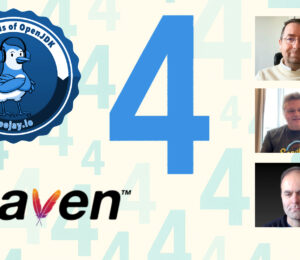Faster Maven Builds (Part 1)
- October 14, 2021
- 3604 Unique Views
- 5 min read
Builds require a few properties, chief among them reproducibility. I would consider speed to be low on the order of priorities. However, it's also one of the most limiting factors to your release cycle: if your build takes T, you cannot release faster than each T. Hence, you'll probably want to speed up your builds after you've reached a certain maturity level to enable more frequent releases.
I want to detail some techniques you can leverage to make your Maven builds faster in this article. The next article focuses on how to do the same inside of Docker.
Baseline
Since I want to propose techniques and evaluate their impact, we need a sample repository. I've chosen Hazelcast code samples because it provides a large enough multi-modules code base with many submodules; the exact commit is 448febd.
The rules are the following:
- I run the command five times to avoid temporary issues
- I execute
mvn cleanbetween each run to start from an emptytargetrepository - All dependencies and plugins are already downloaded
- I report the time that Maven displays in the console log:
[INFO] ------------------------------------------------------- [INFO] BUILD SUCCESS [INFO] ------------------------------------------------------- [INFO] Total time: 22.456 s (Wall Clock) [INFO] Finished at: 2021-09-24T23:20:41+02:00 [INFO] -------------------------------------------------------
Let's start with our baseline, mvn test. The results are:
- 02:00 min
- 01:57 min
- 01:58 min
- 01:56 min
- 01:58 min
Using all CPUs
By default, Maven uses a single thread. In the age of multicores, this is just waste. It's possible to run parallel builds using multiple threads by setting an absolute number or a number relative to the number of available cores. For more information, please check the relevant documentation.
The more submodules that are not dependent on each other you have, i.e., Maven can build them in parallel, the better you'll achieve with this technique. It fits our codebase very well.
We are going to use as many threads as there are available cores. The relevant command is mvn test -T 1C.
When the command starts, you should see the following message in the console:
Using the MultiThreadedBuilder implementation with a thread count of X
- 51.487 s (Wall Clock)
- 40.322 s (Wall Clock)
- 52.468 s (Wall Clock)
- 41.862 s (Wall Clock)
- 41.699 s (Wall Clock)
The numbers are much better but with a higher variance.
Parallel test execution
Parallelization is an excellent technique. We can do the same regarding test execution. By default, the Maven Surefire plugin runs tests sequentially, but it's possible to configure it to run tests in parallel. Please refer to the documentation for the whole set of options.
This approach is excellent if you've got a large number of units in each module. Note that your tests need to be independent of one another.
We will manually set the number of threads:
mvn test -Dparallel=all -DperCoreThreadCount=false -DthreadCount=16 #1 #2
- Configure Surefire to run both classes and methods in parallel
- Manual override the thread count to 16
Let's run it:
- 02:04 min
- 02:03 min
- 01:46 min
- 01:52 min
- 01:53 min
It seems that the cost of thread synchronization offsets the potential gain of running parallel tests.
Offline
Maven will check whether a SNAPSHOT dependency has a new "version" at every run. It means additional network roundtrips. We can prevent this check with the --offline option.
While you should avoid SNAPSHOT dependencies, it's sometimes unavoidable, especially during development.
The command is mvn test -o, -o being the shortcut for --offline.
- 01:46 min
- 01:46 min
- 01:47 min
- 01:55 min
- 01:44 min
The codebase has a considerable number of SNAPSHOT dependencies; hence offline speeds up the build significantly.
JVM parameters
Maven itself is a Java-based application. It means each run starts a new JVM. A JVM first interprets the bytecode and then analyze the workload and compiles the bytecode to native code accordingly: it means peak performance, but only after a (long) while. It's great for long-running processes, not so much for command-line applications.
We will likely not reach the peak performance point in the context of builds since they are relatively short-lived, but we are still paying for the analysis cost. We can configure Maven to forego it by configuring the adequate JVM parameters. Several ways of configuring the JVM are available. The most straightforward way is to create a dedicated jvm.config configuration file in a .mvn subfolder in the project's folder.
-XX:-TieredCompilation -XX:TieredStopAtLevel=1
Let's now simply run mvn test:
- 01:44 min
- 01:44 min
- 01:53 min
- 01:53 min
- 01:55 min
Maven daemon
The Maven daemon is a recent addition to the Maven ecosystem. It draws its inspiration from the Gradle daemon:
Gradle runs on the Java Virtual Machine (JVM) and uses several supporting libraries that require a non-trivial initialization time. As a result, it can sometimes seem a little slow to start. The solution to this problem is the Gradle Daemon: a long-lived background process that executes your builds much more quickly than would otherwise be the case. We accomplish this by avoiding the expensive bootstrapping process and leveraging caching by keeping data about your project in memory.
The Gradle team recognized early that a command-line tool was not the best usage of the JVM. To fix that, one keeps a JVM background process, the daemon, always up. It acts as a server while the CLI itself plays the role of the client.
As an additional benefit, such a long-running process loads classes only once (if they didn't change between runs).
Once you have installed the software, you can run the daemon with the mvnd command instead of the standard mvn one. Here are the results with mvnd test:
- 33.124 s (Wall Clock)
- 33.114 s (Wall Clock)
- 34.440 s (Wall Clock)
- 32.025 s (Wall Clock)
- 29.364 s (Wall Clock)
Note that the daemon uses multiple threads by default, with number of cores - 1.
Mixing and matching
We've seen several ways to speed up the build. What if we used them in conjunction?
Let's first try with every technique we've seen so far in the same run:
mvnd test -Dparallel=all -DperCoreThreadCount=false -DthreadCount=16 -o #1 #2 #3 #4
- Use the Maven daemon
- Run the tests in parallel
- Don't update
SNAPSHOTdependencies - Configure the JVM parameters as above via the
jvm.configfile - no need to set any option
The command returns the following results:
- 27.061 s (Wall Clock)
- 24.457 s (Wall Clock)
- 24.853 s (Wall Clock)
- 25.772 s (Wall Clock)
Thinking about it, the Maven daemon is a long-running process. For that reason, it stands to reason to let the JVM analyze and compile the bytecode to native code. We can thus remove the jvm.config file and re-run the above command. Results are:
- 23.840 s (Wall Clock)
- 26.589 s (Wall Clock)
- 22.283 s (Wall Clock)
- 23.788 s (Wall Clock)
- 22.456 s (Wall Clock)
Now we can display the consolidated results:
| Baseline | Parallel Build | Parallel tests | Offline | JVM params | Daemon | Daemon + offline + parallel tests + parameters | Daemon + offline + parallel tests | |
|---|---|---|---|---|---|---|---|---|
| #1 (s) | 120.00 | 51.00 | 128.00 | 106.00 | 104.00 | 33.12 | 27.06 | 23.84 |
| #2 (s) | 117.00 | 40.00 | 123.00 | 106.00 | 104.00 | 33.11 | 24.46 | 26.59 |
| #3 (s) | 118.00 | 52.00 | 106.00 | 107.00 | 113.00 | 34.44 | 24.85 | 22.28 |
| #4 (s) | 116.00 | 42.00 | 112.00 | 115.00 | 113.00 | 32.03 | 25.77 | 23.79 |
| #5 (s) | 118.00 | 42.00 | 113.00 | 104.00 | 115.00 | 29.36 | 22.46 | |
| Average (s) | *117.80* | 45.40 | 116.40 | 107.60 | 109.80 | 32.41 | 25.54 | 23.79 |
| Deviation | 1.76 | 25.44 | 63.44 | 14.64 | 22.96 | 2.91 | 1.00 | 2.38 |
| Gain from baseline (s) | - | 72.40 | 1.40 | 10.20 | 8.00 | 85.39 | 92.26 | 94.01 |
| % gain | - | 61.46% | 1.19% | 8.66% | 6.79% | 72.48% | 78.32% | 79.80% |
Conclusion
In this post, we have seen several ways to speed up your Maven build. Here's the summary:
- Maven daemon: A solid, safe starting point
- Parallelize builds: When the build contains multiple modules that are independent of each other
- Parallelize tests: When the project contains multiple tests
- Offline: When the project contains
SNAPSHOTdependencies and you don't need to update them - JVM parameters: When you want to go the extra mile
I'd advise every user to start using the Maven daemon and continue optimizing if necessary and depending on your project.
In the next post, we will focus on speeding your Maven builds in-container.
To go further:
Originally published at A Java Geek on October 3rd, 2021
Don’t Forget to Share This Post!









Comments (0)
No comments yet. Be the first.